Everything you need to know about buying and selling secondhand in Sweden
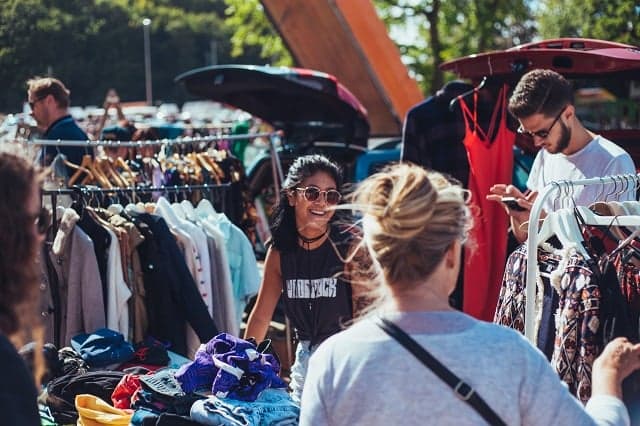
There are plenty of reasons to buy and sell secondhand in Sweden: it can save or earn you money in an expensive country, and it's more sustainable than always buying new. Here's what you need to know if you want to get in on the trend, from tax rules to the best apps for sellers and shoppers.
This article is available to Members of The Local. Read more Membership Exclusives here.
Secondhand shopping is a booming business in Sweden, and flea markets in particular are a favourite summertime activity. But getting involved in buying or selling used items can seem daunting to a newcomer, with everything from commission on sales to tax issues to think about. We've taken a look at six questions and answers which will help you get started.
How can I sell secondhand items online?
If you've got pre-loved items you want to sell in Sweden, there are many options. Which you choose will depend on factors like the amount of time you're willing to put into the sale, where you live, the item's value, and which category it falls into.
Blocket is one of the most popular sites for selling everything from cars to clothes to furniture, where you advertise your item and set a fixed price, paying a fee which depends on the item's category and you can choose to pay extra for things like additional photos or changing the ad. On Tradera, an auction site which also offers fixed price options, it's free to post an ad but they will take a ten percent commission of at least 3 and up to 150 kronor per item sold. A big advantage of these two sites is their popularity; lots of users means a high chance of making a sale.
Two options which are free to post advertisements and where the site does not take a commission are Shpock (which offers both fixed price and auction options, and the idea is that you sell to people in the local area), Citiboard, and American-owned LetGo.
Another site which is a bit different is Sellpy: unlike the others, you don't need to set up the advert or communicate with buyers yourself, but instead send off your used items (clothing, electronics, toys and interior decoration) to Sellpy. They then sort through and decide what's worth selling, and set their own prices on their website and via Tradera. While this is the lowest effort option for sellers, the major downside is the lack of control over prices and whether things are put up for sale at all, and the fact Sellpy takes a bigger cut of profits than Blocket, Tradera or Shpock. Sellers get 40 percent of the item's sale price, minus 10 kronor for each item they try to sell. This means that if many of your items fail to sell, you could even end up making a loss.
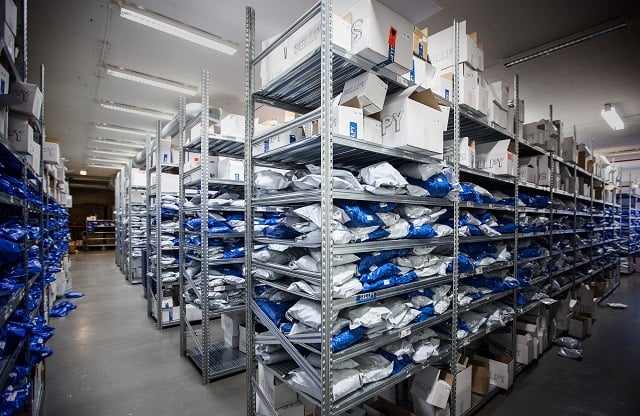 The Sellpy warehouse. Photo: Adam Wrafter / SvD / TT
The Sellpy warehouse. Photo: Adam Wrafter / SvD / TT
There are also more specialized options, such as Campus Bokhandeln, Bokus and Studentapan where you can buy and sell used textbooks, AllForSale which focuses on furniture and specifically office furniture, or Diskant for musical instruments and equipment.
And lastly, there are a number of Facebook groups dedicated to buying and selling, usually dedicated to certain cities or categories of item, or you could try your luck at advertising your items in a community Facebook group via Facebook Marketplace, which is free to use. For example, expat groups might be a good place to sell your old Swedish textbooks, while a parenting group would be the right place to advertise kid's clothing.
READ ALSO: How to save money despite living in Sweden
How can I sell secondhand items in person, or to a shop?
To sell things in person, the most popular option is to attend an organized loppis or flea market. These are hugely popular in Sweden, and you'll typically pay a small fee to rent a table. You can sell everything from furniture (chairs and lamps are always popular!) and kitchenware to clothes, books, and miscellaneous items. The rules vary from place to place, including whether you need to pre-book a spot or can just turn up, and how much it costs to take part.
There are a few different kinds of loppis: a baklucekloppis is a car-boot sale where you sell things out of your car; a drive-in loppis is the same thing except there's no need to book your spot: and a bordsloppis or torgloppis are markets where you sell things from a table, and they take place indoors and outdoors respectively. Check websites such as loppistajm.se or svenskaloppisar.se to find one near you.
The top tips for success are the same as at flea markets in any country. Get there early, especially if spots aren't designated so that you can get in prime position; lay out your items as attractively as possible (consider bringing a mirror if you're selling lots of clothes, and arrange your items into different categories); smile and greet everyone who walks past. You can prepare by making sure your items are all cleaned and clothes are ironed, bringing packaging materials like newspaper or bubblewrap for any delicate items, and perhaps used plastic or paper bags, and think about how you'll catch people's attention -- perhaps with nicely made signs or an unusual item that can serve as a talking point.
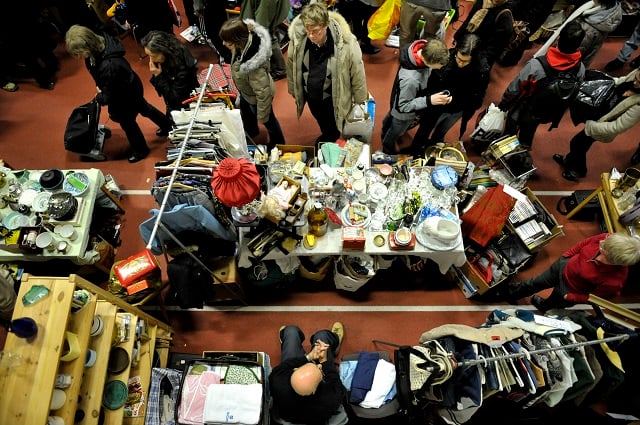
An indoor loppis in Stockholm. File photo: Jessica Gow / SCANPIX
Most transactions at flea markets take place using the payment app Swish, so make sure you have that set up on your phone and have your number on display to make it as easy as possible for your customers. It's worth being aware that not everyone has Swish and the app does sometimes experience technical difficulties, so bring along a float of change as well so you can accept cash.
Another option for secondhand selling is to find a shop where you're able to sell your own items. These are rare in Sweden, since it's more common to donate used items to a charity shop if you're not selling them yourself at a flea market. But a few do exist, such as Loppis Lounge in Malmö, where you can hire a spot for your items to be put on sale. Prices start at 85 kronor for one shelf for a week, plus 15 percent of your profits are taken as commission.
If you have items that are a bit more specialized, for example valuable ornaments, books or furniture, it's worth contacting an antiques shop (antikvariat) to see if they'd be happy to buy them.
LIVING IN SWEDEN:
-
How to set up your first bank account in Sweden
-
The best tips for a move to Sweden (from people who've been there, done that)
-
How to buy the Swedish summer house of your dreams
What tax issues do I need to know about as a secondhand seller in Sweden?
If you're selling your own belongings secondhand, you're allowed to make a profit of up to 50,000 kronor each year without needing to pay tax on it (the reasoning being that you paid tax on the items when they were first bought). If you really catch the loppis bug and start buying things to sell on at a market, or start making more than 50,000 kronor from your own used items, you should look into the taxes that apply.
The basic rule is that if you're selling your own items, profit over 50,000 kronor is taxed as income from capital, but you can deduct the purchase cost (or a standard deduction of 25 percent of the sale price if the purchase price is unknown). But be aware that some items are considered exceptions to this, such as collectable items, artwork and more -- see a full list here. For those who buy and sell on for profit, you should pay tax on all your profit, which is usually classed as having your own business. Find out more on the Swedish Tax Agency's website.
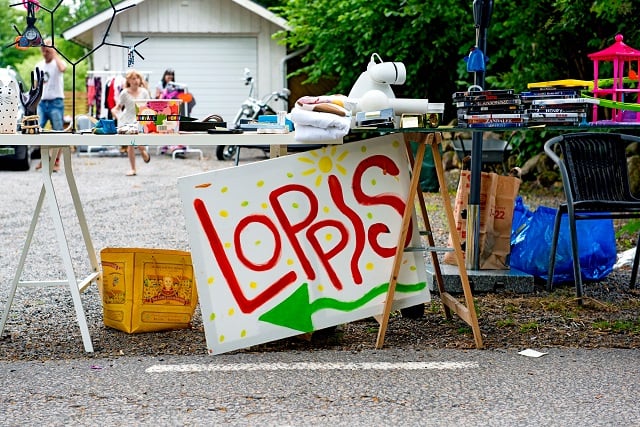
Photo: Aline Lessner/imagebank.sweden.se
Where can I buy secondhand online?
All the online sites mentioned above can be used for buying as well as selling: Blocket, Tradera, Shpock, Sellpy, Citiboard, Letgo and Facebook Marketplace. Note that eBay doesn't operate in Sweden; it owns Tradera, so you can either shop there or use eBay's sites in other countries (but make sure to check shipping fees!).
Which site you choose to use will depend on a few things: if you're looking for a large item such as furniture, you might prefer a site with a local focus such as Blocket's city sections or Shpock to make delivery or pick-up easier, and if it's a high value item you might look for an option which allows you to communicate with the seller and ask questions before buying.
Where can I buy secondhand in person?
Some of Sweden's major secondhand chains are run by charities, including the Salvation Army's Myrorna, Stadsmissionen (run by the homelessness charity of the same name), and the Röda Korset shops run by the Red Cross. Their stores vary in size, and typically sell a range of items including clothes and accessories, sports equipment, books, furniture and household items, all donated.
For lovers of vintage clothes, Stockholm is a haven, with the SoFo (meaning 'south of Folkungagatan') area of the Södermalm island home to the densest concentration of vintage clothes stores. But you'll also find vintage stores up and down the country, and not only for clothes: look out for antique and secondhand stores selling a whole range of items.
Check out the comprehensive guide to pre-loved shopping in Skåne, Blekinge, Halland and Småland. And the ReTuna mall in Eskilstuna is supposedly the world's first entirely secondhand shopping centre, so head there to browse over 200 shops.
READ ALSO: 15 Stockholm vintage shops to lose yourself in
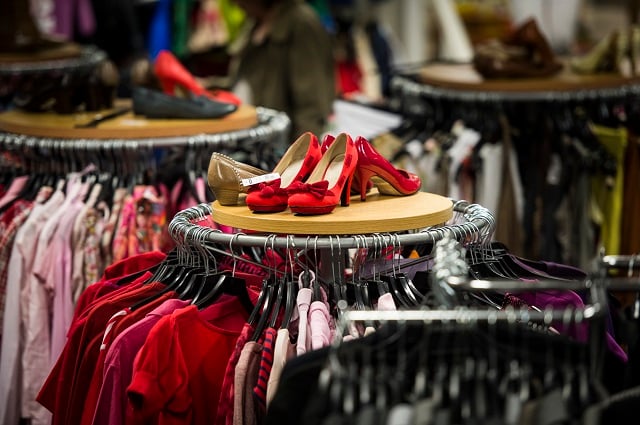 Myrorna. Photo: Nora Lorek / TT
Myrorna. Photo: Nora Lorek / TT
What are my rights as a secondhand shopper in Sweden?
If you're shopping in a secondhand store, you're covered by Sweden's Consumer Sales Act. This means you still have the right to return items if they are faulty and the shop did not clearly warn you about the defect before the purchase – it is the responsibility of the retailer to ensure goods are in saleable condition and that shoppers are made aware of any problems.
If on the other hand you simply decide you don't like the item after buying it, you're probably out of luck. Some Swedish retailers have an öppet köp (literally 'open purchase') policy allowing you to return items if you change your mind, but there's no legal requirement to offer it and many secondhand stores don't offer this. You can always ask at the time of purchase.
And you need to be especially careful when buying from a private individual, for example at a loppis or via a classifieds site. The Consumer Sales Act does not apply in these cases, but the Sale of Goods Act does apply, and under that act people are forbidden from selling faulty items. If you're sold a faulty item at a loppis, you need to lodge a complaint with the District Court. Try to have a close look at the item before buying and make sure any defects are factored into the price.
It's always preferable to be completely sure about your items before you buy it, so for any bigger purchases (more expensive furniture, for example), make sure you have a record such as a Swish payment or a receipt, and consider drawing up a contract for any really big buys. You can find contract templates for items such as jetskis, cars, and motorbikes in Swedish here.
READ ALSO: A guide to your consumer rights when shopping in Sweden
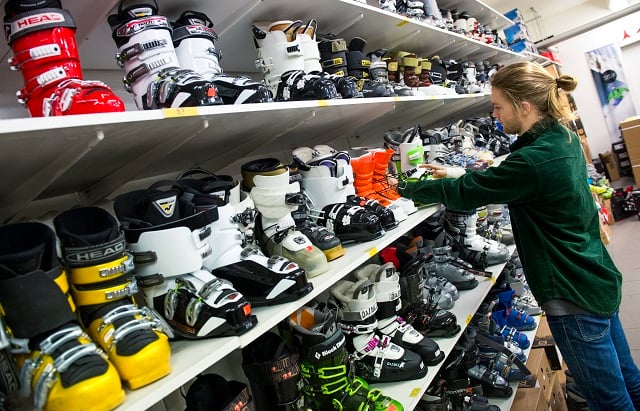
Photo: Claudio Bresciani / TT
Comments
See Also
How can I sell secondhand items online?
If you've got pre-loved items you want to sell in Sweden, there are many options. Which you choose will depend on factors like the amount of time you're willing to put into the sale, where you live, the item's value, and which category it falls into.
Blocket is one of the most popular sites for selling everything from cars to clothes to furniture, where you advertise your item and set a fixed price, paying a fee which depends on the item's category and you can choose to pay extra for things like additional photos or changing the ad. On Tradera, an auction site which also offers fixed price options, it's free to post an ad but they will take a ten percent commission of at least 3 and up to 150 kronor per item sold. A big advantage of these two sites is their popularity; lots of users means a high chance of making a sale.
Two options which are free to post advertisements and where the site does not take a commission are Shpock (which offers both fixed price and auction options, and the idea is that you sell to people in the local area), Citiboard, and American-owned LetGo.
Another site which is a bit different is Sellpy: unlike the others, you don't need to set up the advert or communicate with buyers yourself, but instead send off your used items (clothing, electronics, toys and interior decoration) to Sellpy. They then sort through and decide what's worth selling, and set their own prices on their website and via Tradera. While this is the lowest effort option for sellers, the major downside is the lack of control over prices and whether things are put up for sale at all, and the fact Sellpy takes a bigger cut of profits than Blocket, Tradera or Shpock. Sellers get 40 percent of the item's sale price, minus 10 kronor for each item they try to sell. This means that if many of your items fail to sell, you could even end up making a loss.
 The Sellpy warehouse. Photo: Adam Wrafter / SvD / TT
The Sellpy warehouse. Photo: Adam Wrafter / SvD / TT
There are also more specialized options, such as Campus Bokhandeln, Bokus and Studentapan where you can buy and sell used textbooks, AllForSale which focuses on furniture and specifically office furniture, or Diskant for musical instruments and equipment.
And lastly, there are a number of Facebook groups dedicated to buying and selling, usually dedicated to certain cities or categories of item, or you could try your luck at advertising your items in a community Facebook group via Facebook Marketplace, which is free to use. For example, expat groups might be a good place to sell your old Swedish textbooks, while a parenting group would be the right place to advertise kid's clothing.
READ ALSO: How to save money despite living in Sweden
How can I sell secondhand items in person, or to a shop?
To sell things in person, the most popular option is to attend an organized loppis or flea market. These are hugely popular in Sweden, and you'll typically pay a small fee to rent a table. You can sell everything from furniture (chairs and lamps are always popular!) and kitchenware to clothes, books, and miscellaneous items. The rules vary from place to place, including whether you need to pre-book a spot or can just turn up, and how much it costs to take part.
There are a few different kinds of loppis: a baklucekloppis is a car-boot sale where you sell things out of your car; a drive-in loppis is the same thing except there's no need to book your spot: and a bordsloppis or torgloppis are markets where you sell things from a table, and they take place indoors and outdoors respectively. Check websites such as loppistajm.se or svenskaloppisar.se to find one near you.
The top tips for success are the same as at flea markets in any country. Get there early, especially if spots aren't designated so that you can get in prime position; lay out your items as attractively as possible (consider bringing a mirror if you're selling lots of clothes, and arrange your items into different categories); smile and greet everyone who walks past. You can prepare by making sure your items are all cleaned and clothes are ironed, bringing packaging materials like newspaper or bubblewrap for any delicate items, and perhaps used plastic or paper bags, and think about how you'll catch people's attention -- perhaps with nicely made signs or an unusual item that can serve as a talking point.

An indoor loppis in Stockholm. File photo: Jessica Gow / SCANPIX
Most transactions at flea markets take place using the payment app Swish, so make sure you have that set up on your phone and have your number on display to make it as easy as possible for your customers. It's worth being aware that not everyone has Swish and the app does sometimes experience technical difficulties, so bring along a float of change as well so you can accept cash.
Another option for secondhand selling is to find a shop where you're able to sell your own items. These are rare in Sweden, since it's more common to donate used items to a charity shop if you're not selling them yourself at a flea market. But a few do exist, such as Loppis Lounge in Malmö, where you can hire a spot for your items to be put on sale. Prices start at 85 kronor for one shelf for a week, plus 15 percent of your profits are taken as commission.
If you have items that are a bit more specialized, for example valuable ornaments, books or furniture, it's worth contacting an antiques shop (antikvariat) to see if they'd be happy to buy them.
LIVING IN SWEDEN:
- How to set up your first bank account in Sweden
- The best tips for a move to Sweden (from people who've been there, done that)
- How to buy the Swedish summer house of your dreams
What tax issues do I need to know about as a secondhand seller in Sweden?
If you're selling your own belongings secondhand, you're allowed to make a profit of up to 50,000 kronor each year without needing to pay tax on it (the reasoning being that you paid tax on the items when they were first bought). If you really catch the loppis bug and start buying things to sell on at a market, or start making more than 50,000 kronor from your own used items, you should look into the taxes that apply.
The basic rule is that if you're selling your own items, profit over 50,000 kronor is taxed as income from capital, but you can deduct the purchase cost (or a standard deduction of 25 percent of the sale price if the purchase price is unknown). But be aware that some items are considered exceptions to this, such as collectable items, artwork and more -- see a full list here. For those who buy and sell on for profit, you should pay tax on all your profit, which is usually classed as having your own business. Find out more on the Swedish Tax Agency's website.

Photo: Aline Lessner/imagebank.sweden.se
Where can I buy secondhand online?
All the online sites mentioned above can be used for buying as well as selling: Blocket, Tradera, Shpock, Sellpy, Citiboard, Letgo and Facebook Marketplace. Note that eBay doesn't operate in Sweden; it owns Tradera, so you can either shop there or use eBay's sites in other countries (but make sure to check shipping fees!).
Which site you choose to use will depend on a few things: if you're looking for a large item such as furniture, you might prefer a site with a local focus such as Blocket's city sections or Shpock to make delivery or pick-up easier, and if it's a high value item you might look for an option which allows you to communicate with the seller and ask questions before buying.
Where can I buy secondhand in person?
Some of Sweden's major secondhand chains are run by charities, including the Salvation Army's Myrorna, Stadsmissionen (run by the homelessness charity of the same name), and the Röda Korset shops run by the Red Cross. Their stores vary in size, and typically sell a range of items including clothes and accessories, sports equipment, books, furniture and household items, all donated.
For lovers of vintage clothes, Stockholm is a haven, with the SoFo (meaning 'south of Folkungagatan') area of the Södermalm island home to the densest concentration of vintage clothes stores. But you'll also find vintage stores up and down the country, and not only for clothes: look out for antique and secondhand stores selling a whole range of items.
Check out the comprehensive guide to pre-loved shopping in Skåne, Blekinge, Halland and Småland. And the ReTuna mall in Eskilstuna is supposedly the world's first entirely secondhand shopping centre, so head there to browse over 200 shops.
READ ALSO: 15 Stockholm vintage shops to lose yourself in
 Myrorna. Photo: Nora Lorek / TT
Myrorna. Photo: Nora Lorek / TT
What are my rights as a secondhand shopper in Sweden?
If you're shopping in a secondhand store, you're covered by Sweden's Consumer Sales Act. This means you still have the right to return items if they are faulty and the shop did not clearly warn you about the defect before the purchase – it is the responsibility of the retailer to ensure goods are in saleable condition and that shoppers are made aware of any problems.
If on the other hand you simply decide you don't like the item after buying it, you're probably out of luck. Some Swedish retailers have an öppet köp (literally 'open purchase') policy allowing you to return items if you change your mind, but there's no legal requirement to offer it and many secondhand stores don't offer this. You can always ask at the time of purchase.
And you need to be especially careful when buying from a private individual, for example at a loppis or via a classifieds site. The Consumer Sales Act does not apply in these cases, but the Sale of Goods Act does apply, and under that act people are forbidden from selling faulty items. If you're sold a faulty item at a loppis, you need to lodge a complaint with the District Court. Try to have a close look at the item before buying and make sure any defects are factored into the price.
It's always preferable to be completely sure about your items before you buy it, so for any bigger purchases (more expensive furniture, for example), make sure you have a record such as a Swish payment or a receipt, and consider drawing up a contract for any really big buys. You can find contract templates for items such as jetskis, cars, and motorbikes in Swedish here.
READ ALSO: A guide to your consumer rights when shopping in Sweden

Photo: Claudio Bresciani / TT
Join the conversation in our comments section below. Share your own views and experience and if you have a question or suggestion for our journalists then email us at [email protected].
Please keep comments civil, constructive and on topic – and make sure to read our terms of use before getting involved.
Please log in here to leave a comment.